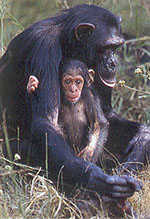CHIMPANZEE

How to Recognize
Chimpanzees are manís closest living relative as we share 98% to 99% of our genes with them. They are an agile, muscular ape, blue-black to dark brown in color, with expressive faces, low brows, long arms, short legs, and no tail. They have naked palms, soles, and butts. Their hands can grip firmly, allowing them to pick up objects.
Habitat
Chimps require a rich year-around food supply and they prefer productive, moist forests. However, the chimp is very adaptable and be found in habitats ranging from dry woodland to dry savanna.
Behavior
They are highly sociable, living in communities numbering up to 120. Individuals may also spend considerable time alone. They forage in territories protected by males. These males spend their entire lives on ancestral turf in shifting hierarchies. Females will disperse to other communities. Adults weave tree nests for sleeping and siestas.
Chimps are among the noisiest of all wild animals and use a complicated system of sounds to communicate with each other. A loud "wraaa" call, which can be heard more than a mile away, warns of something unusual or disturbing. They hoot "hoo-hoo-hoo," scream, grunt, and drum on hollow trees with the flat of their hands, sometimes for hours.
Chimps touch each other a great deal and may kiss when they meet. They also hold hands and groom each other. An adult chimp often has a special "friend" or companion which it spends a lot of time with. Female chimps give their young a great deal of attention and help each other with babysitting chores. Older chimps in the group are usually quite patient with energetic youngsters.
Breeding
An infant is born after an eight-month gestation. They are weaned by five months but are dependent until they are six to eight years old. Young chimps laugh, turn somersaults, tickle each other, play tag, and cry real tears. Juveniles play with infants and with other small monkeys.
Feeding
Primarily vegetarians, chimps consume fruit that is in season (they love figs), bark, stems, and leaves with the occasional meal of insects, nestling birds, eggs, and larger prey such as bushpigs and guinea fowl. After meals, they partake in reciprocal grooming sessions.
Enemies
Humans. Adult chimps mount organized hunts for red colobus and other species which are ripped apart and eaten. They will jump and kill lone males, and drag females back to their community.
Examples of Human-Like Behaviors
-- Subordinate males beg with hands.
-- Females grant sexual favors for a share of prized meat.
-- Use rocks to break open nutshells and stems to extract termites from a hole.
-- Groom leaves to get attention.
-- Use moss to soak up drinking water.
-- Use a leaf as a napkin.
-- Make cushions to sit on.
-- Eat medicinal plants when feeling sick.
-- Drum on tree buttresses to advertise a food source.
-- Sit and gaze at waterfalls.
-- Break into frenzied drumming and hooting during rainstorms.
-- Punch another baboon in the stomach and an uppercut to the jaw.
-- A captive group was witnessed shuffling around in a circle stamping out a rhythm.
TOP OF PAGE
Copyright © 2002, Dawn M. Dalton.
All rights reserved.
**LINKS**
WHERE?
WHY?
ITINERARY
PLAN YOUR TRIP
GETTING THERE
LONDON
KENYA
UGANDA
SAFETY
ITEMS BOUGHT
STAYING HEALTHY
COMMENTS
HOME
BHS HOME
---Animal Facts--
Baboon
Buffalo
Cheetah
Chimpanzee
Crocodile
Eland
Elephant
Gazelle
Giant Forest Hog
Giraffe
Gorilla
Hippopotamus
Hyena
Hyrax
Impala
Jackal
Lion
Mongoose
Monkey
Ostrich
Rhinoceros
Topi
Uganda Kob
Warthog
Waterbuck
Wildebeest
Zebra